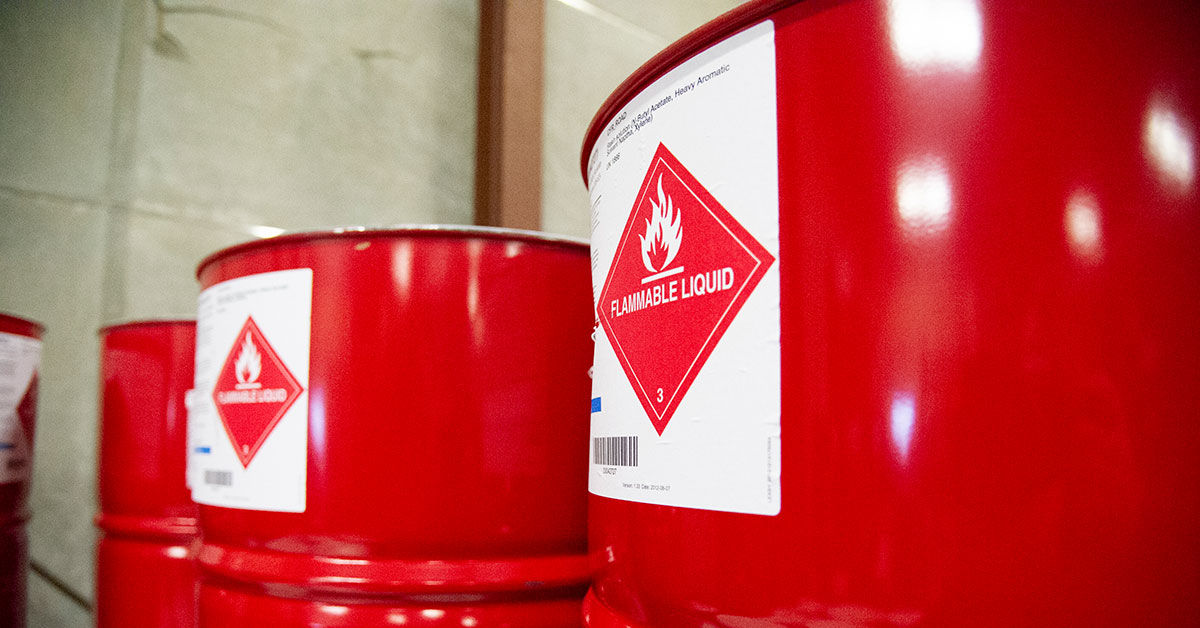Safely handling flammable and combustible liquids
Date Posted: 06/30/2025

Employees often handle flammable liquids such as solvents, paint thinners, and fuel on an everyday basis. Something used so often can’t be that dangerous, right? In reality, these are some of the most hazardous chemicals workers are exposed to. Make sure your employees understand how to identify, handle, and store flammable and combustible liquids.
Although there are no training requirements in OSHA’s standard on flammable liquids (29 CFR 1910.106), employees must have training on the hazards of these chemicals to meet the requirements of the Hazard Communication Standard (29 CFR 1910.1200).
Classes of flammable and combustible liquids
Flammable liquids ignite easily and burn quickly, and have flashpoints below 100º F. Examples include gasoline, acetone, and methanol.
The flashpoint is the temperature at which a liquid produces enough vapors to be ignited. More than any other factor, flashpoint determines the flammability hazard of a liquid; the lower the flashpoint, the more flammable the material. Flammable liquids are known as “Class I” liquids.
There are three classes of flammable liquids:
- Class IA liquids have flashpoints below 73º F and boiling points below 100º F.
- Class IB liquids have flashpoints below 73º F and boiling points at or above 100º F.
- Class IC liquids have flashpoints at or above 73º F and below 100º F.
A combustible liquid has a flashpoint at or above 100º F up to 200º F. Examples include diesel fuel and motor oil. Combustible liquids are divided into three classes:
- Class II liquids have flashpoints at or above 100º F and below 140º F.
- Class IIIA liquids have flashpoints at or above 140º F and below 200º F.
- Class IIIB liquids have flashpoints at or above 200º F.
Use and storage
Fire prevention is especially important where flammable and combustible liquids are used. Employees should not use flammable and combustible liquids where there are any open flames, sparks, or other sources of ignition, such as welding.
To avoid dangerous sparks caused by static electricity, containers of flammable liquids must be properly grounded and bonded while dispensing the liquid.
Storage must be in approved containers (drums, safety cans, etc.). Containers must be closed when not in use. The regulation at 29 CFR 1910.106 describes permissible storage containers by size and material (such as glass, plastic, and metal) for various categories of liquids.
OSHA has special requirements for lighting and other electrical wiring used in flammable liquid storage rooms. Containers may also be kept in approved storage cabinets. OSHA sets limits on how much flammable or combustible liquid can be stored in one area.
Fire extinguishers must be available where flammable and combustible liquids are stored. Employers may be required to post a “no smoking” sign even if the company prohibits smoking on the premises.
How Safety Management Suite Can Help
The topic index in the J. J. Keller® SAFETY MANAGEMENT SUITE provides an A-Z listing of all things safety. Simply search for or choose a topic, and you’ll be directed to everything SAFETY MANAGEMENT SUITE has to offer for that topic, including ezExplanations®, regulations, OSHA interpretations and other guidance, resources for delivering training, and more.
E-mail Newsletter
Sign up to receive the weekly EHS Insider email newsletter for safety articles, news headlines, regulatory alerts, industry events, webcasts, and more.